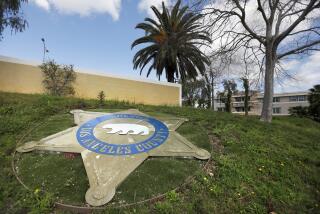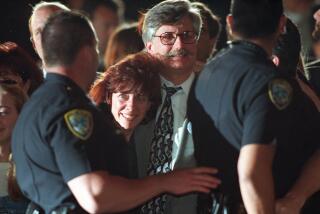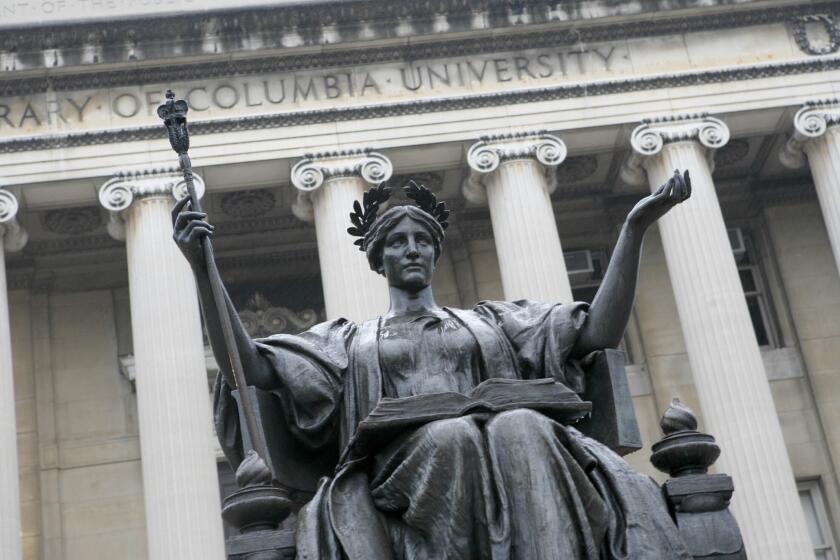Nonprofit aims to engage children with science
For a kid who says he wants to build robots, 10-year-old Jabari Griffie came to the right place.
The fifth-grader was among hundreds of curious kids who turned out Saturday morning for the grand opening of Iridescent, a nonprofit science and discovery center near downtown Los Angeles.
The first exhibit Jabari saw featured something even cooler than a robot: An underwater robot.
Remote control in hand, Jabari grinned broadly as he maneuvered the device in an apparent effort to make it crash into another one in the same wading pool.
Such positive encounters between children and science are what Tara Chklovski, the founder of Iridescent, is hoping to foster.
“It’s all about the love of learning,” said Chklovski, 32, who was pursuing a doctorate in aerodynamics at USC four years ago when her idea for Iridescent took flight.
The nonprofit has since trained more than 300 college-level engineering students to mentor nearly 5,000 children, most of them from inner-city schools with limited science programs. Iridescent is set to open another studio in New York next month and operates out of various schools in the Bay Area.
Its biggest financial backer is the Navy, which provided a $2.3-million grant in hopes of “developing future engineers and scientists” who will be the technological brains behind the military’s brawn in years to come.
Eddie C. Riley, a spokesman for the Office of Naval Research, said statistics show that students in the United States have been falling behind in science and math for years and that minorities have been historically underrepresented in both areas.
“We’re working hard to try to close the gap,” he said.
The Iridescent facility in Los Angeles is on 23rd Street, between Figueroa and Flower streets. It’s no accident that it’s in the shadow of USC. Most of the volunteer teachers are USC engineering students who receive credit toward their engineering degrees for participating in the nonprofit.
The site will essentially be a science clubhouse where children will learn through hands-on experiments. One aspect of the program requires youngsters to submit project proposals that will be considered by the staff. Those chosen will be given $200 for supplies and will be paired with a volunteer.
Although Saturday was the ceremonial grand opening, Iridescent has been holding periodic workshops, including one called “Pull Apart.” As the name implies, it has children dismantle items to see how they work.
Eliana Cotom, 9, was a natural.
Since attending the five-week workshop, she has pulled apart a toy microwave, a toy laptop and a bubble-maker, none of which has she put back together.
Perhaps that is why her mother, Ana, denied her most recent request: to dismantle the family car.
“Not yet,” she said.
Ana Cotom said the experience had sparked in her daughter a heightened interest in learning.
“She’s become more curious and more passionate,” she said as Eliana sat nearby, eager to get on to the next activity. “And, to me, that’s the point.”
The grand opening was essentially a science street fair, with exhibits on sound waves, avionics, submersibles, wind tunnels and lots of other stuff. All were designed to draw kids in with cool demonstrations, then reveal the science behind the spectacle.
Jim Rohr, a civilian engineer for the Navy, got lots of oohs and aahs with experiments involving the simplest of materials. In one, he took a $1.80 footlong rod from Home Depot, squeezed it between his thumb and forefinger and slid them up and down. Soon, the rod began emitting a high-pitched whine that sounded as if it were produced by electricity.
As wide-eyed kids (and some parents) looked on, Rohr said: “Remember, it’s not magic. It’s science.”
More to Read
Start your day right
Sign up for Essential California for news, features and recommendations from the L.A. Times and beyond in your inbox six days a week.
You may occasionally receive promotional content from the Los Angeles Times.







